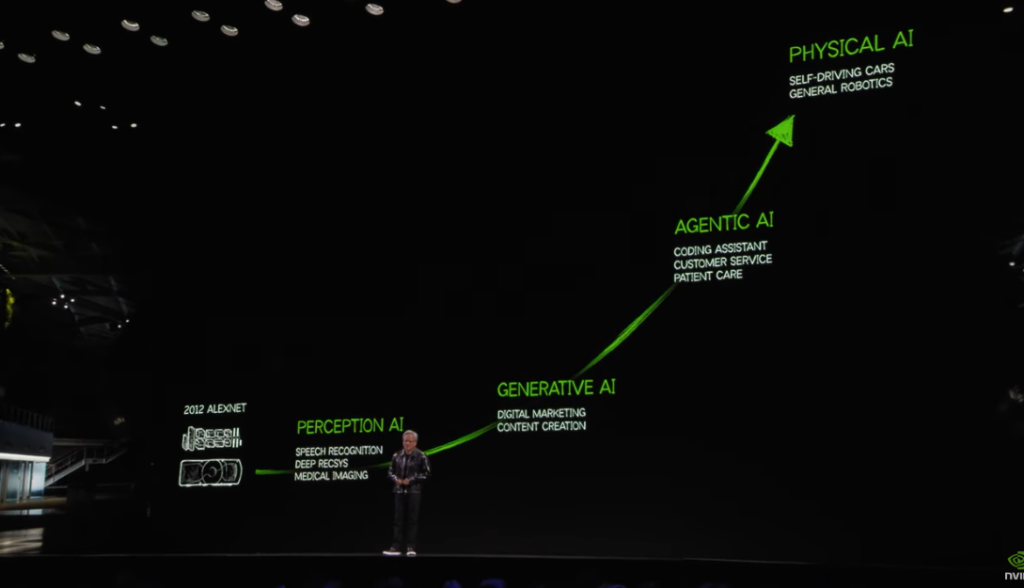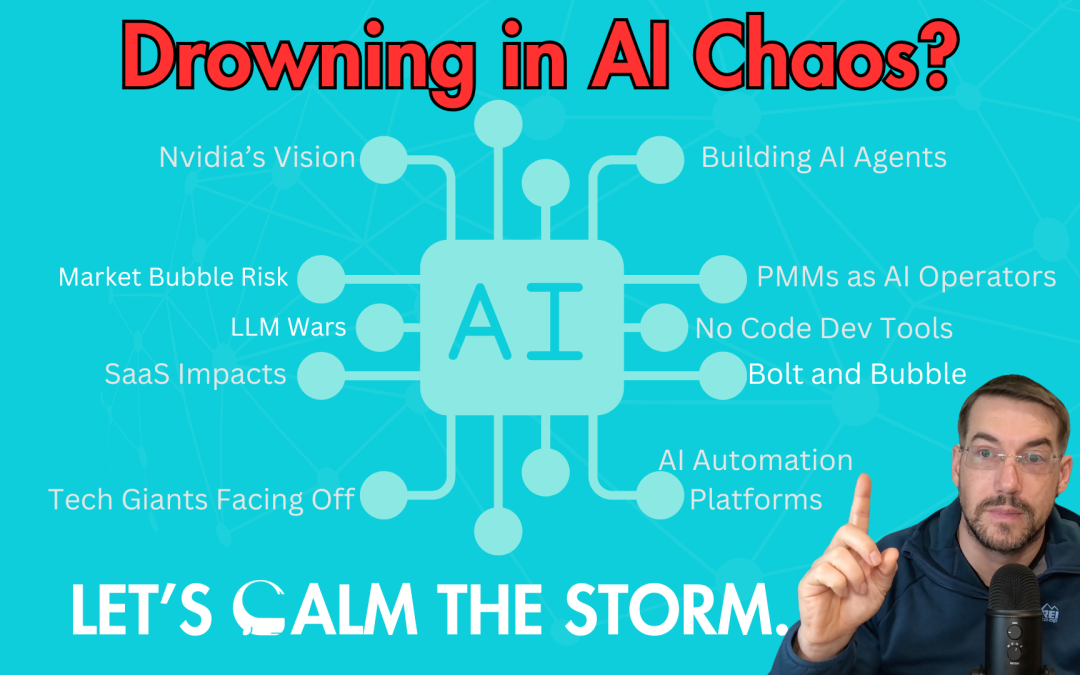If you’re feeling like you’re drowning in the noise, you’re not alone.
The pace of AI innovation is overwhelming. My LinkedIn feed has turned into a firehose of AI chaos, LLM wars, new product launches, and endless market shifts.
For product marketers, the challenge isn’t just keeping up—it’s figuring out what actually matters. Which innovations are real? Which are just hype? And most importantly, how do we use AI in product marketing?
I’ve made it my mission to cut through the chaos and decode the AI landscape for product marketers. Let’s calm the storm.
In this video, you will find all the details I covered in my latest research on this topic, and I think it will be worth your time. Please help me by sharing this content with your network, subscribing to the YouTube channel, and subscribing to the podcast (Spotify, Apple).
The Keynote That Woke Me Up
Last month, I watched Jensen Huang’s CES keynote, and it shifted my entire perspective on AI. He introduced the concept of Agentic AI—AI that doesn’t just generate content, but perceives, reasons, plans, and acts. This isn’t just the next phase of AI; it’s the start of a massive transformation in how work gets done.

Huang made a bold prediction: “The IT department is going to be the HR department for AI agents.” That’s a profound shift. Instead of just hiring people, businesses will start hiring AI workers to execute complex tasks autonomously.
This also reminded me of the dot-com boom—massive investments, sky-high valuations, and a feeling that we’re on the edge of something huge. The question is: Are we in an AI bubble?
After the DeepSeek release, we saw a 20% drop in Nvidia’s stock, dragging down the Nasdaq in the process. AI isn’t just a technological shift—it’s a market force with ripple effects that impact everything. If you weren’t awake to AI at the start of 2025, you sure better be now. Change is happening.
From Product Marketers to AI Operators
I also made an attempt to do more than just scroll and consume AI news—I wanted to test AI tools myself. What’s all the hype about? Can PMMs really become AI operators as I stated in my last post and use AI in product marketing?
The first platform of nearly 30 tools I tried was Bolt.new, a tool that lets you build an app using natural language commands. No coding, no CS degree—just typing out what I wanted, and Bolt did the rest. Within minutes, I had a working interface for an app I had envisioned on the back of a napkin sitting in a McDonald’s over 15 years ago. To me, this is decreasing the “napkin barrier”, by allowing anyone to enter the role of a developer and creator.

And it’s not just developing apps that’s becoming accessible. By using tools like invideo.io, I can easily pump out videos in minutes, that align to a script that I feed it. With these tools we are seeing the beginning of a full stack PMM model, whereby I can build content and go to market with AI tools doing much of the heavy lifting, once their configured. This also means less sinking startup money into paying agencies or software developers – that day is here. It’s a heyday for entrepreneurs.
However this also means everyone has this capability and the key will be figuring out how to apply AI in practice. It’s like the old Mark Twain quote, “the man who doesn’t read has no advantage over the man who cannot read.” It’s the same for these AI capabilities. There’s no point in learning about them if we can’t put them into use.
Then I also discovered Bubble.io, another AI-powered development tool. It allowed me to build a fully functional app interface that used agents and subagents with drag-and-drop simplicity. In less than an hour, I had gone from product marketer to AI-powered developer. It’s totally feasible. Give it a try!
The AI Ecosystem is Moving Faster Than Ever
The more I explored, the clearer it became — this is a transformational time in technology, and if I want to stay ahead I need to get up to speed, fast. And this shouldn’t just be about studying the tools, it’s about applying them in practice. There are so many tools out there now, and so much VC funding pouring in, that it’s impossible to keep up. But here are a few findings:
- Companies and platforms like LangChain, Hugging Face, and Pinecone are rapidly building the infrastructure for AI-driven, agentic workflows. I recommend giving them each a look. You can also use this prompt: “Provide me a list of the most used AI Agent development platforms and tools, and include hyperlinks so I can quickly visit their sites.”
- Enterprises are moving AI development in-house—just think of any random enterprise, let’s just pick Hertz car rentals — they can now create internal AI agents to sift through and make sense of decades of data instead of relying on third-party LLMs.
- AI agents are embedding into everyday business processes, and traditional job functions are shifting fast. Tools like Relevance AI, Letta AI, and many more are enabling agentic AI at a rapid pace. It’s important to get up to speed I recommend you just create a quick sign up with your Google or other account. It only takes minutes to sign up and test them out.
- Existing Tech Giants and SaaS Vendors are All in: It can’t be avoided, every major tech player is all-in on AI because if they aren’t they will become irrelevant. Just look at the shifts Salesforce, Hubspot and other big SaaS players have made. They are at risk if they don’t adapt. And then the tech giants are in full force either through LLMs or enabling developers in their ecosystems to build with LLMs and AI agent development tools.
Note: I will be sharing more on the AI innovation ecosystem in my next post/podcast episode – stay tuned!
Product marketing will not be immune to this shift. The question isn’t if AI will impact our roles—it’s how fast it will happen. Also, how can we create a way to drive innovation in product marketing with open source tools and frameworks?
The Human Factor—Where Do We Fit In?
Despite the advancements in AI, there’s still a need for human oversight. Tools like Zapier and Make are automating workflows, but they still require a person to connect systems, validate outputs, and prevent errors.

That’s the key insight: automation makes humans more efficient, but it doesn’t eliminate the need for strategy and decision-making. It’s not unlike the SOAR market in cyber, which is promoted as a way to decrease manual effort and be more efficient, but experts are still needed to implement SOAR correctly. Automation isn’t easy. I have been in the SOAR market in one way or another for nearly 10 years now, and I can tell you that SOAR adoption is always harder than SOAR messaging.
But how long before AI becomes reliable enough to execute PMM tasks without human intervention? That moment is coming faster than most realize. I hope to keep exploring the available tools out there to crack this code, and will to share what I learn in the process.
The Future of AI in Product Marketing
Right now, GenAI is accelerating the pace of content creation and messaging. But product marketers still play a crucial role in curating insights, testing messaging, and ensuring alignment with business goals. AI won’t replace our ability to work cross-functionally and align organizations toward a similar objective. We still need to operate as part of a broader team/org.
It’s just that the way orgs are structured today won’t last because a single AI-driven employee can be as productive as a team of 10 with the right tools and automation in place.
We’re moving toward a future where AI won’t just assist product marketing—it will execute it. The PMMs who master AI tools today will be the ones leading the future of product marketing.
What’s Next?
I’m focused on testing, breaking, and figuring out which AI tools actually move the needle for product marketers. There’s a ton of AI chaos—but there are also tools that can radically change how we work.
I want to hear from you. What AI tools are you using? What’s overwhelming? What’s blowing your mind? Let’s crack this AI code together.
Stay tuned for future posts by subscribing to the following options:
- Subscribe to the newsletter on LinkedIn or Substack. (You can also subscribe directly below.)
- Follow Cyber PMM and/or me on LinkedIn.
- Subscribe to the YouTube channel.
- Subscribe to the Podcast on Spotify or Apple.


